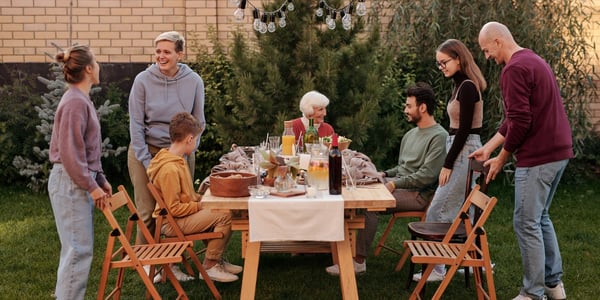Hobbies are a fantastic way for older adults to keep their minds and bodies active while also...
Watch for These Tripping Hazards in Your Home and Yard
Tripping hazards in the home can go unnoticed until they cause an irreversible accident. It is reported by the CDC that more than 25% of adults 65 and older fall each year. While some falls are relatively harmless, approximately 20% of falls result in serious injuries such as broken bones or a head injury. Fortunately, you can take simple precautionary steps to minimize the risk of falling in your home. It's important to recognize the potential hazards and take proactive measures to prevent falls and related injuries. By identifying and addressing these potential hazards, you can create a safer environment for yourself and your loved ones. In this blog post, we'll explore these common tripping hazards and provide practical tips for managing them to reduce the risk of falling in your home and yard.
Tripping Hazards to Watch for at Home
Extension Cords
Extension cords provide convenience in homes, especially those without enough outlets. It is common to see extension cords used to run kitchen appliances, entertainment systems, home offices, and equipment in the garage. They are especially popular around holidays to power lights or other decorations. However, extension cords also present a significant tripping risk. They often run across the ground and can catch your foot while walking.
How to Manage the Risk:
- Consider using an extension cord hanger, so cords run up along the wall instead of across the ground
- If the cord must run along the ground, cover it with a designated cord cover, rug, or tape so it is easier to walk over safely
- Use shorter extensions where possible to avoid excess length creating additional hazards
- Where extension cords are frequently used, consider installing additional outlets instead
Clutter
Clutter can take different forms, e.g., scattered books, toys, shoes, clothes, and even empty tins. Nevertheless, the more clutter, the greater the risk of tripping.
How to Manage the Risk:
- Talk to the children and enforce rules on cleaning their toys when they are done playing with them
- Hire a cleaning service to help keep the house tidy
- Avoid piling up stuff in the room
- Walk through the home and identify whether items causing clutter can be donated or thrown out. Click here to learn more about how to successfully declutter!
Inadequate Lighting
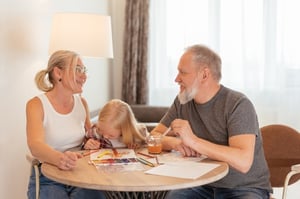 Older adults are often more sensitive to inadequate lighting than others in the home. Poor lighting can make it easier to trip over something difficult to see or more likely to knock something over into the walking path. Furthermore, inadequate lighting in areas like stairways can cause trips when one stair is missed. Consequently, excess lighting from bulbs can cause glare, which is also dangerous for those walking throughout the home.
Older adults are often more sensitive to inadequate lighting than others in the home. Poor lighting can make it easier to trip over something difficult to see or more likely to knock something over into the walking path. Furthermore, inadequate lighting in areas like stairways can cause trips when one stair is missed. Consequently, excess lighting from bulbs can cause glare, which is also dangerous for those walking throughout the home.
How to Manage the Risk:
- Ensure all light fixtures have functioning bulbs installed
- Check that all light switches are in accessible locations
- Install lights in pathways and other relevant areas in the home to ensure the home is well lit
- Keep flashlights in appropriate locations
Rugs and carpets
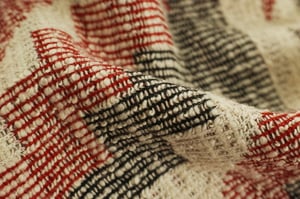 Rugs and carpets not only improve the aesthetic appeal of the house but also keep it warm. Nonetheless, rugs and mats can cause tripping hazards that are easy to overlook. They can get scrunched up or folded over, creating an uneven surface. Some, especially those of poor quality, can even wear out and bare hanging threads that can pose a tripping hazard. Sometimes, even a rug that is in the correct position can create enough of a difference in height from the other flooring surface that it can affect someone's balance.
Rugs and carpets not only improve the aesthetic appeal of the house but also keep it warm. Nonetheless, rugs and mats can cause tripping hazards that are easy to overlook. They can get scrunched up or folded over, creating an uneven surface. Some, especially those of poor quality, can even wear out and bare hanging threads that can pose a tripping hazard. Sometimes, even a rug that is in the correct position can create enough of a difference in height from the other flooring surface that it can affect someone's balance.
How to Manage the Risk:
- Ensure all rugs and carpets are fixed to the floor or wall to avoid clumping.
- Hold carpet using sofa sets to ensure they are flat and tight.
- Get rid of old carpets and rugs that will cause you much pain of losing a loved one.
- Ensure there is sufficient lighting to see where the rug begins.
Slippery Floors
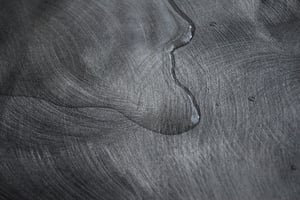 Slippery floors are primarily caused by spills on the floor. Older adults might have a difficult time cleaning messes on the ground. Additionally, children can be very messy during meals, particularly with minimum supervision. These spills can bring about dangerous falls, especially if they go unnoticed.
Slippery floors are primarily caused by spills on the floor. Older adults might have a difficult time cleaning messes on the ground. Additionally, children can be very messy during meals, particularly with minimum supervision. These spills can bring about dangerous falls, especially if they go unnoticed.
How to Manage the Risk:
- Immediately wipe up any spills on the floor. Avoid postponing
- Be there with the kids during meal time to ensure they do not waste food by dropping particles all over
- Ensure kitchen lighting is adequate to see spills before stepping on them
- Wear slip-resistant shoes in the kitchen and bathroom
Uneven stairs
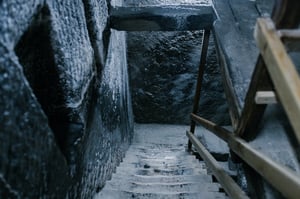 Staircases can be difficult for older people to manage, especially when too steep or uneven. Staircases may be unavoidable in the home, but it is important to ensure they are not creating more risks than necessary.
Staircases can be difficult for older people to manage, especially when too steep or uneven. Staircases may be unavoidable in the home, but it is important to ensure they are not creating more risks than necessary.
How to Manage the Risk:
- Ensure steps are built to a consistent size
- If possible, install stairlifts to make moving back and forth easy
- For slippery hardwood stairs, add a well-fitted carpet or other nonslip materials to make them less slippery
Pets
.jpg?width=300&name=pexels-cottonbro-7118310%20(1).jpg) Pets are fun and adorable around the home and dear to our hearts. However, they can be a significant hazard. Some pets may lie around on the floor in walking areas. Others may leave toys everywhere or even run around under your feet while you are walking!
Pets are fun and adorable around the home and dear to our hearts. However, they can be a significant hazard. Some pets may lie around on the floor in walking areas. Others may leave toys everywhere or even run around under your feet while you are walking!
How to Manage the Risk:
- Limit the number of toys your pets have access to at any time
- Give your pet a collar with a bell on it so you can hear if they are running toward you while you are walking
- Enroll your pet in obedience classes so they better listen to your commands and know how to walk alongside you.
The list of tripping hazards is endless depending on the design of the house and the vulnerable occupants. All the same, it is impossible to manage these hazards without knowing them, including the tiniest. Taking these precautions can help to minimize the risks of tripping in and around your home.




